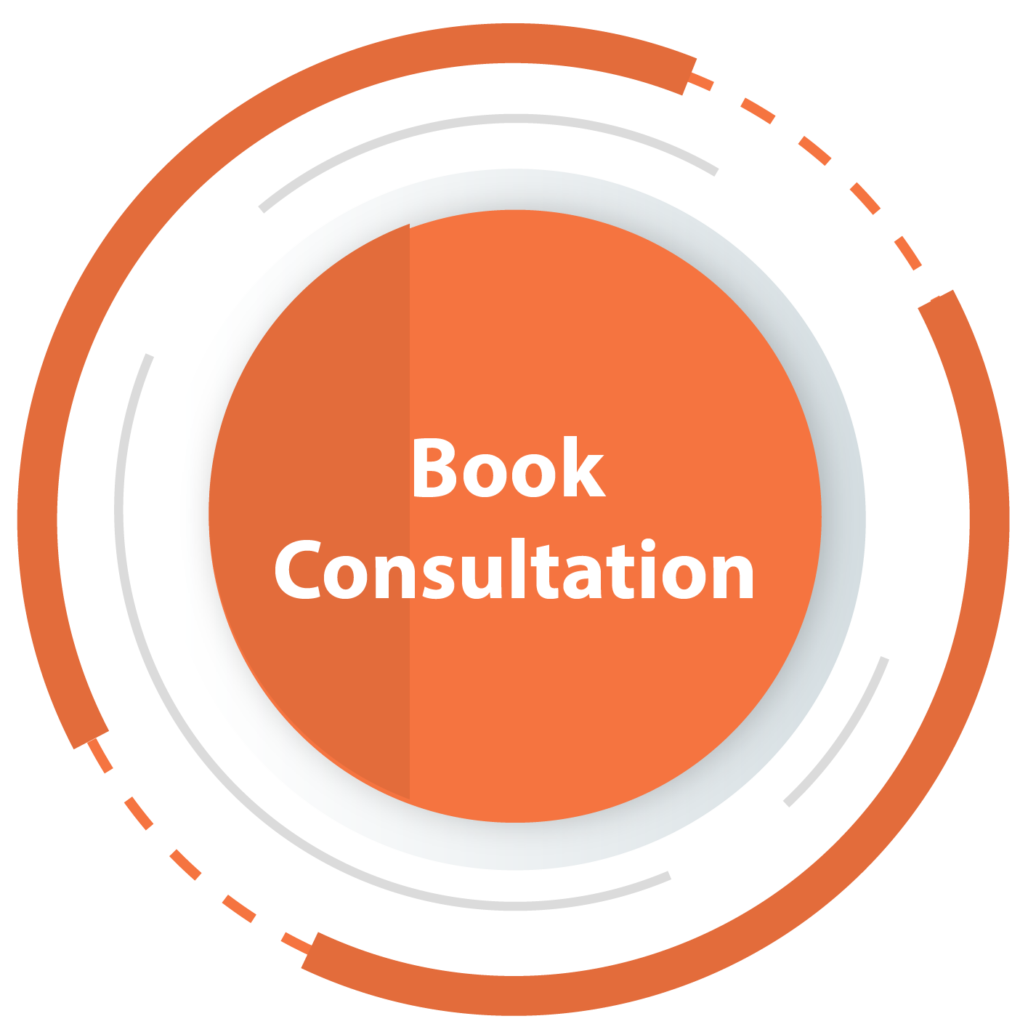Head
The head is the superior part of the body that is attached to the trunk by the neck. It consists of a fleshy outer portion surrounding the bony skull, within which sits the brain. The head rests on the neck, and is provided bony support for movement by the seven cervical vertebrae. It is the control and communication centre as well as the “loading dock” for the body. It houses the brain and therefore is the site of our consciousness: ideas, creativity, imagination, responses, decision making and memory. The human head is also home to all the body’s major sensory organs, which are the brain, eyes, ears, nose, tongue and nerves. The most important of these is the brain, as without a functioning brain, they’d all be useless.
Brain
One of the largest and most complex & important organ in the human body which is made up of more than 100 billion nerves that communicate in trillions of connections called synapses and acts as the Command center for the human nervous system receving input from the sensory organs and sending output to the muscles. It’s a soft spongy mass of tissue which is protected by 22 bones of the skull from penetrating injuries; and 3 thin membranes called meninges that separates the skull and the brain. Watery fluid called Cerebrospinal Fluid (CSF) fills the ventricles and meninges, allowing the brain to float within the skull and acts as cushion to the brain.
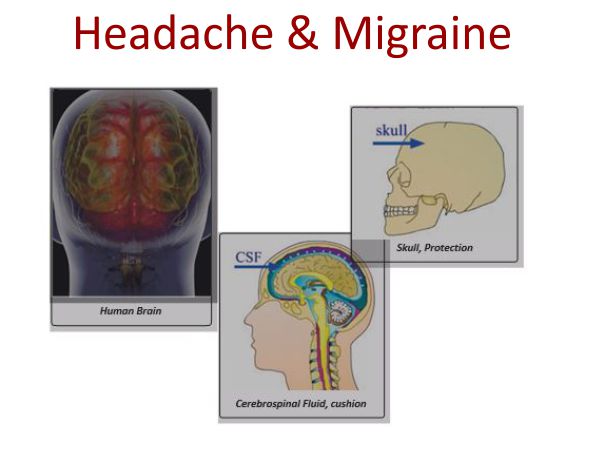
- Head Tapping
- Yoga Therapy
- Depression
- Anxiety
- Personality changes
- Aggression
- Headache & Migraine
- Substance abuse to control mood and pain, and many more
- Cerebrum
- Cerebellum
- Brainstem
Brain is made up of two types of tissues, the grey matter and white matter. Grey matter is involved in analyzing information, whereas the white matter conducts information between grey matter areas. The ratio of grey to white matter changes as we aged.
The brain is composed of main three parts. They work together but each has specific functions:
CereBrum
The cerebrum is the largest part of the brain. The surface of the cerebrum is called the cortex, containing neurons (the grey matter), which are interconnected to other brain areas by axons (white matter). The cortex has a folded appearance.

The cerebrum is composed of right and left hemispheres. Right hemisphere controls the left side of the body, and the left hemisphere controls the right side. Left hemisphere regulates language and speech, while the right hemisphere controls non-verbal spatial skills. Each hemisphere is then divided into four lobes:
Frontal Lobe
Most anterior, right under the forehead; controls intellectual activities, such as the ability to organize, as well as personality, behavior and emotional control.
Parietal Lobe
Near the back and top of the head above the ears; controls the ability to read, write and understand spatial relationships.
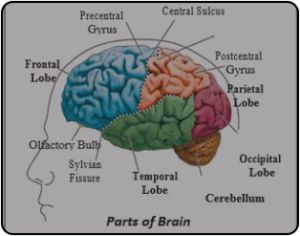
Occipital Lobe
Most posterior, at the back of the head and it controls sight.
Temporal Lobe
Side of head above ears situated immediately behind and below the frontal lobes; controls memory, speech and comprehension.
CereBellum
Located at the base of the skull under the cerebrum and connected to the brainstem, it co-ordinates muscle movements, maintain posture and balance.
Brainstem
Lower part of brain and acts as a relay center connecting the cerebrum and cerebellum to the spinal cord, performing many automatic functions such as breathing, heart rate, body temperature, wake and sleep cycles, digestion, sneezing, coughing, vomiting and swallowing. The brainstem are divided into three levels, the midbrain, the pons and the medulla.

There are a total of 12 pairs of cranial nerves that originate from our brain and brain stem. Cranial nerves relay information between the brain and parts of the body, primarily to and from regions of the head and neck. Each cranial nerve carries different functions related to different senses of the body. Apart from sensory functions there are also some that work as motor nerves or mixed nerves. Cranial nerves are also considered components of the peripheral nervous system.
The 12 cranial nerves are:
1. Olfactory
Sensory nerve that contributes in the smelling senses, providing the specific cells that are termed as olfactory epithelium. It carries the information from the nasal epithelium to the olfactory centre in the brain.2. Optic
Sensory nerve that transforms information about vision to the brain, supplying information to the retina in the form of ganglion cells.3. Oculomotor
Motor nerve that supplies to different centres along the midbrain. Its functions include superiorly uplifting the eyelid, superiorly rotating the eyeball, construction of the pupil on the exposure to light and operating several eye muscles.4. Trochlear
Motor nerve that supplies to the midbrain and performs the function of handling the eye muscles and turning the eye.5. Trigeminal
Largest cranial nerve in all, performing many sensory functions related to the nose, eyes, tongue and teeth. It’s divided into three branches: ophthalmic, maxillary and mandibular nerve. It’s mixed nerve because it performs both sensory and motor functions in the brain.6. Abducent
Motor nerve that supplies to the pons and performs the function of turning the eye laterally.7. Facial
Motor nerve responsible for different types of facial expressions and it performs some functions of sensory nerve by supplying information about touch on the face and senses of tongue in the mouth.8. Vestibulocochlear
Motor nerve responsible in providing information related to balance of head and sense of sound or hearing. It carries vestibular as well as cochlear information to the brain and is placed near the inner ear.9. Glossopharyngeal
Sensory nerve carrying sensory information from the pharynx which is the initial portion of throat and some portion of tongue and palate. Send information about temperature, pressure and other related facts. Additionally, it covers also some portion of taste buds and salivary glands, as well as carrying some motor functions such as helping in swallowing food.10. Vagus
Mixed nerve that carries both motor and sensory functions, dealing with the area of the pharynx, larynx, esophagus, trachea, bronchi, some portion of heart and palate. It constricts muscles of the above areas, as well as contributing in the tasting ability in the sensory part.11. Spinal accessory
Motor nerve supplying information about the spinal cord, trapezius and other surrounding muscles, and provides muscle movement of the shoulders and surrounding neck.12. Hypoglossal
Motor nerve dealing with the muscles of tongue.The brain being a complex and delicate organ, is vulnerable to injury that can result in language or speech difficulties and sensory or motor problems. Brain injuries can lead to temporary or permanent changes in the brain, including:
HEADACHE & MIGRANE
HEADACHE
Headache is one of the most common medical complaints which most people experience them at some point in their life. Headache is defined as a pain arising from the head or upper neck of the body. The pain originates from the tissues and structures that surround the skull or the brain because the brain itself has no nerves that give rise to the sensation of pain (pain fibers). The thin layer of tissue (periosteum) that surrounds bones, muscles that encase the skull, sinuses, eyes, and ears, as well as thin tissues that cover the surface of the brain and spinal cord (meninges), arteries, veins, and nerves, all can become inflamed or irritated and cause headache. The pain may be a dull ache, sharp, throbbing, constant, intermittent, mild, or intense.

A headache can be a sign of stress or emotional distress, or it can result from a medical Issues, such as migraine or high blood pressure, anxiety or depression. It can also lead to other problems and can affect anyone regardless of age, race and gender. Headaches are can be classified as Primary or Secondary. Primary headaches are benign, recurrent headaches not caused by underlying Issuesor structural problems. For example, migraine is a type of primary headache. While primary headaches may cause significant daily pain and disability, they are not dangerous. Secondary headaches are caused by an underlying disease, like an infection, head injury, vascular Issuess, brain bleed or tumors. It can be harmless or dangerous.
MIGRAINE
Migraine is the result of specific physiologic changes that occur within the brain that leads to the characteristic pain and associated symptoms of a migraine. Migraines are intense throbbing headaches occurring on one or both sides of the head, usually on one side. The pain is accompanied by other symptoms such as nausea, vomiting, blurred vision and aversion to light, sound, and movement. Migraines are often triggered by food items, such as red wine, chocolate and aged cheeses.

For women, a hormonal connection is likely, since headaches occur at specific points in the menstrual cycle, with use of oral contraceptives, or the use of hormone replacement therapy after menopause. The symptoms will vary from person to person, and individuals may have different symptoms during different attacks which may differ in length and frequency. The exact cause of migraine is not known. Changes in neurotransmitter levels within the brain are thought to play a role. Migrane can have an enormous impact on our lives.
COMPLEMENTORY THERAPY
Head Tapping
Using Brahmi Taila (Kshreebala Taila) and Navaratna Oil (Cooling Oil), Hair dryer, disposable shower cap, towels

- Pour few drops of Brahmi Oil or Kshreebala on your palm and massage on patient’s scalp focusing on the sutures.
- Start tapping the head along the sutures for 5-7 minutes.
- Then switch on the hair dryer using moderate heat and continue tapping along the sutures for another 3 minutes.
- Repeat another round of all the steps above.
- Next, pour few drops of Navaratna Oil on palm and massage on patient’s scalp and tap the head along the sutures for 7 minutes.** Navaratna oil will give a cooling effect on the head
- Then switch on the hair dryer again using moderate heat and continue tapping along the sutures for another 3 minutes** Purpose of using the hair dryer
The heat will open up the pores of the scalp and this will allow the oil to penetrate deep inside the head through the sutures.
 At the end of the complementary Management, cover patient’s head with shower cap** Purpose of tapping the head
At the end of the complementary Management, cover patient’s head with shower cap** Purpose of tapping the headBrain is made up of 4 lobes joined together. The point where these lobes meet are known as sutures. Head Tapping is done midly at these points. By doing so, it allows the herbal oil used to enter into the sutures and thus strengthening the brain.
Yoga Therapy (30-40 minutes)
- Preparatory Practices
- Quick Relaxation Technique (QRT)
- Main Practice: Breathing
- Head Rotation / Rolling
- Deep Relaxation Technique (DRT)

1) Preparatory Practices (10 rounds of each)
Starting pose: Tadasana (standing position)
- Head / Neck Rotation with Breathing – Left & Right
- Head / Neck Bending with Breathing – Left & Right
- Head / Neck Bending with Breathing – Backward & Downward
 Shoulder rotation (clockwise and counter clockwise)
Shoulder rotation (clockwise and counter clockwise) Fingers on shoulders
Fingers on shoulders- Place the tips of the fingers on top of the shoulders
- Bring the elbows forward together
- Rotate the elbows upwards, then backwards and downwards. Synchronize the movements with breathing. Repeat in opposite direction
- Forward Bend and Partial Back Bend
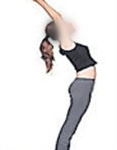 Apart your legs as far as possible
Apart your legs as far as possible Place your hands on the hips with the thumbs pointing forward and the fingers pointing backwards
Place your hands on the hips with the thumbs pointing forward and the fingers pointing backwards- While inhaling bend backward from the waist
- While exhaling bend forward, bringing head to the ground keeping legs straight
- Ankle Stretching breathing
- Place palms in front of your thighs
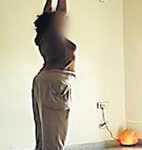 While inhaling, raise your hands and stretch the ankles. Standing tall and firm on your heels
While inhaling, raise your hands and stretch the ankles. Standing tall and firm on your heels- As you exhale, bring your hands and heels down
- Synchronise the breathing with the movements
- Hand Stretching Breathing ( Practice 5 rounds each ) Horizontal
- While inhaling, stretch the arms straight out in front of your body so that the arms are at shoulder level. At the same time, turn your palms to face outwards
- While exhaling, reverse the process and bring your palms to your chest, collapsing the shoulders

At 135°
– While inhaling, turn your palms to face upwards and stretch the arms above the forehand at an angle of 135°.–
 While exhaling, reverse the process and bring your palms to your chest, shoulders collapsed.
While exhaling, reverse the process and bring your palms to your chest, shoulders collapsed.Vertical
– While inhaling, turn your palms to face upwards and stretch the arms vertically above the head.– While exhaling, reverse the process and bring your palms to your chest, shoulders collapsed.
2) Quick Relaxation Technique
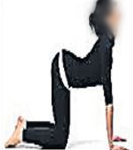

3) Main Practice: Breathing (Starting pose in Vajrasana)
a. Tiger breathing (9 rounds)– Stand on your knees. Arms, thighs and heels should be shoulder width apart. Shoulder and wrist in one straight line.– While inhaling, raise the head and look at the ceiling. Depress the spine, making it concave.– While exhaling, round your shoulders, bend the head down and bring the chin towards the chest.b. Rabbit breathing (3 rounds of 10 breaths)
 – Bring knees together, bend forward and rest the forearms on the floor, keeping elbows by the side of the knees and palms flat on the ground– Maintain the head at a distance of one hand length from the ground to chin. Open your mouth partially. Protrude the tongue partially. Touch the lower lip resting on the lower set of teeth.– Graze at a point about 2 feet on the ground in front of you– Pant quickly like a rabbit, using only the upper part of the chest for 10 breaths. Repeat twice– Close your mouth and relax in Sasankasana. Stretch your hands forward with forehead resting on the ground. Chest and thorax relaxedc. Dog breathing (3 rounds of 10 breaths)– Place palms on the ground beside the knees– Make the spine slightly concave and fix gaze straight ahead– Mouth wide open; tongue pushed out to its maximum. Inhale and exhale rapid and forceful, expanding and contracting the abdomen vigorously.– Relax in Sasankasanad. Sasankasana (3 minutes)– Hands behind the back, make a fist of the right hand and use the left hand to hold right wrist– While inhaling, bend backwards from the waist opening up the chest– While exhaling, slowly bend forward from the waist bringing the forehead on to the ground in front of the knees– While inhaling, slowly come up to the vertical position
– Bring knees together, bend forward and rest the forearms on the floor, keeping elbows by the side of the knees and palms flat on the ground– Maintain the head at a distance of one hand length from the ground to chin. Open your mouth partially. Protrude the tongue partially. Touch the lower lip resting on the lower set of teeth.– Graze at a point about 2 feet on the ground in front of you– Pant quickly like a rabbit, using only the upper part of the chest for 10 breaths. Repeat twice– Close your mouth and relax in Sasankasana. Stretch your hands forward with forehead resting on the ground. Chest and thorax relaxedc. Dog breathing (3 rounds of 10 breaths)– Place palms on the ground beside the knees– Make the spine slightly concave and fix gaze straight ahead– Mouth wide open; tongue pushed out to its maximum. Inhale and exhale rapid and forceful, expanding and contracting the abdomen vigorously.– Relax in Sasankasanad. Sasankasana (3 minutes)– Hands behind the back, make a fist of the right hand and use the left hand to hold right wrist– While inhaling, bend backwards from the waist opening up the chest– While exhaling, slowly bend forward from the waist bringing the forehead on to the ground in front of the knees– While inhaling, slowly come up to the vertical position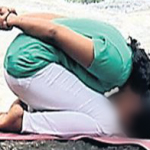 e. Sasankasana with chanting (M-Kara) 2 minutes– Hands behind the back, make a fist of the right hand and use the left hand to hold right wrist. Shoulders relaxed– While inhaling, bend backwards from the waist opening up the chest– While exhaling, chant M-Kara and slowly bend forward from the waist bringing the forehead on to the ground in front of the knees. Collapse the shoulders– While inhaling slowly come up to the vertical position and and repeat all steps for 2 minutes
e. Sasankasana with chanting (M-Kara) 2 minutes– Hands behind the back, make a fist of the right hand and use the left hand to hold right wrist. Shoulders relaxed– While inhaling, bend backwards from the waist opening up the chest– While exhaling, chant M-Kara and slowly bend forward from the waist bringing the forehead on to the ground in front of the knees. Collapse the shoulders– While inhaling slowly come up to the vertical position and and repeat all steps for 2 minutes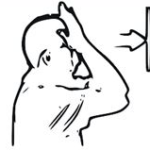
4) Head Rotation / Rolling (Starting pose: Sitting pose)
a. Head Pressure all four directions – 3 minutes– Forward: Patient to interlock their fingers and place palms on forehead. At exhalation, ask patient to push forward, while you use your hands to push in opposite direction, creating resistance. Then inhaling while returning to normal position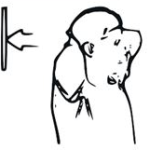 – Backward: Patient to interlock their fingers and place palms on behind the head. At exhalation, ask patient to lean back, while you use your hands to push their head forward, creating resistance. Then inhaling while returning to normal position
– Backward: Patient to interlock their fingers and place palms on behind the head. At exhalation, ask patient to lean back, while you use your hands to push their head forward, creating resistance. Then inhaling while returning to normal position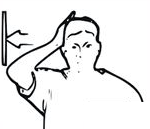 – Right side: Patient to place palm on the right side of the ear. At exhalation, ask patient push their head to the right, while you use your hands to push their head to the left, creating resistance
– Right side: Patient to place palm on the right side of the ear. At exhalation, ask patient push their head to the right, while you use your hands to push their head to the left, creating resistance – Left side: Patient to place palm on the left side of the ear. At exhalation, ask patient push their head to the left, while you use your hands to push their head to the right, creating resistance.
– Left side: Patient to place palm on the left side of the ear. At exhalation, ask patient push their head to the left, while you use your hands to push their head to the right, creating resistance.b. Head Pressure all four directions with chanting (M-Kara) – 2 minutes
** Same steps as above but chanting M-Kara at each exhalationc. Head rolling on pillow without chanting – 3 minutes
- – Sit in Vajrasana; place a pillow in front of patient
- – Bend forward at the waist; bring your head onto the pillow with forehead touching the pillow.
- – While inhaling, roll head forward till the crown touches the pillow. Exhaling and roll the head till the forehead touches the pillow > Practice 1 minute.
- – While inhaling, roll head to your right and let the crown touches the pillow. While exhaling, roll head till forehead touches the pillow. Practice 1 minute. Repeat on the left side for 1 minute.
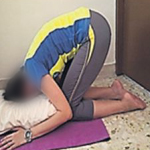
d. Head rolling with chanting (M-Kara) 2 minutes
- – Sit in Vajrasana; place a pillow in front of patient
- – Bend forward at the waist; bring your head onto the pillow with forehead touching the pillow
- – While inhaling, roll your head forward till the crown touches the pillow. While exhaling, chant M-Kara with crown on the pillow. Then slowly roll the head back till the forehead touches the pillow. Repeat another 2 rounds.
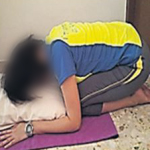 – Next while inhaling, roll your head to your right and let the crown touches the pillow. Start exhaling and chant M-Kara while crown touches the pillow. Then slowly roll your head till forehead touches the pillow. Repeat another 2 rounds.
– Next while inhaling, roll your head to your right and let the crown touches the pillow. Start exhaling and chant M-Kara while crown touches the pillow. Then slowly roll your head till forehead touches the pillow. Repeat another 2 rounds.- – Repeat the same on the left side.
5) Deep Relaxation Technique (DRT)
Subtle Point
- Therapist should assist patient with weak neck
- Head should be stable on the yoga mat, Pressure applied should be moderate
Indication
- Migraine, Headache, Insomnia, Vertigo
Contraindication
- Patient having giddiness & vomiting, head injuries
- Retina Diabetic Retinopathy
Acknowledgement to:
- CYT / ATTC Students of Union Yoga Ayurveda Singapore
- Swami Vivekananda Yoga Prakashana Trust, Bangalore
Disclaimer
Yoga Ayurveda Therapy is Complementary Medicine and doesn't alternates any conventional treatment.
Yoga-Ayurveda Therapy needs physical assistance which may need physical touch. You can ask teacher or therapist not to give physical touch or assistance and based on whatever you choose, our teacher or therapist will follow the instructions. Any point you want to change the preference, then please inform teacher or therapist and management in writing. You will take responsibility of your decision and will not hold Union Yoga Ayurveda responsible for any kind of damage.
All kind of Yoga Ayurveda teaching and therapy can cause certain injuries and you are accepting those injuries. Signing up for the therapy or yoga courses means that you are aware of the probable injuries.
Union Yoga Ayurveda (Union Centre Pte Ltd) and its staff are not liable or responsible for any injuries caused during the session which are visible or not visible, physical or hormonal or mental. You as client take full responsibility of your own decision and will not claim any kind of compensation in terms of money or any resources for the damage caused because of due process.
Related Topics
- Yoga Therapy & Common Ailments
- Diabetes Mellitus
- Yoga & Glaucoma
- Chronic Myeloid Leukemia
- Gastro-Esophageal Reflux / Gastritis
- High Blood Pressure
- For Anxiety neurosis, Depressions etc
- For Neurological issues
- Cataract and short / long Sightedness
- Scoliosis / Herneated disc / Sciatica
- Menstrual Issues

